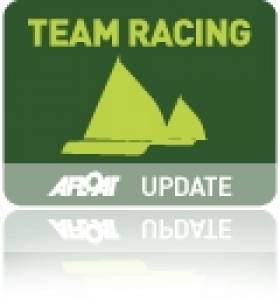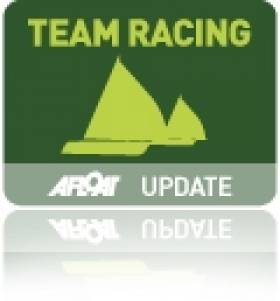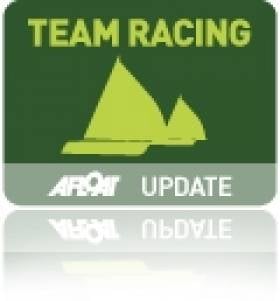Displaying items by tag: team race
University Sailors Head for Schull Team Race Championships Hosted By UCC Sailing Club
#varsitysailing – The upcoming Irish University Sailing Association Intervarsity Championships will be hosted by the University College Cork Sailing Club next weekend.
This team racing event will run from the 26th to the 28th of February in the Fastnet Marine Outdoor Education Centre in Schull, Co. Cork. The F.M.O.E.C. is no stranger to events of this calibre, having hosted the Team Racing World Championships in 2011.
28 teams will travel from 9 colleges in Ireland, namely University College Cork, Cork Institute of Technology, University of Limerick, National University of Ireland Galway, University College Dublin, Trinity College Dublin, Dublin City University, Dublin Institute of Technology, and Queens University Belfast. The Scottish University Sailing Association will also be represented by two teams from Loughborough University.
Following day one, teams will be divided into Gold, Silver and Bronze fleets, and will race in these respective fleets on day two. On the third day, the top teams in each fleet will compete in the finals series.
In 2013/2014 the Intervarsity title was won by University College Dublin, with University College Cork finishing in second place, and University of Cork (2) in third position.
Schull Alumni Win ITRA Trials for the ISAF Team Racing Worlds
#teamrace – The Schull Alumni team showed themselves to be the 'in form' team, confirming their ITRA Irish team racing Champion status.
The ISAF Team Racing World Championship is the ultimate test of the three boat versus three boat format. The Irish Team Racing Association ran trials on 14th February to select the Irish representatives. The event was sailed in light airs within Dun Laoghaire Harbour with five teams competing in the double round robin. Royal St George Yacht Club's excellent Fireflies provided the ideal platform, as identical boats will be used in the Worlds on Rutland Water, UK.
In the first match Alumni were drawn against rivals George Knights as youth and speed took on the experience and cunning of the Knights. It was cut and thrust from the warning signal with no quarter asked for or given. The umpires were kept busy answering protests. Schull got the upper hand and retained control sailing faster to take the first match in the rubber. The second match saw the George Knights start strongly but were reeled in by Schull's superior speed. It was all to play for down the run but Knights held onto the lead with a 1,4-5. Mark 4 saw 4 boats frenetically tacking and gybing as Schull tried to get into a winning combination. The George held the combination with last place swapping between the teams but a misjudgement by Knights on the finish line saw Schull sneak the win. The George didn't drop another match (6 wins) and Schull (7 wins) fell only to Aidan McLaverty's Hoop Dream, who took third place with 4 wins.
ITRA will recommend to the ISA that Alumni and Knights be selected as IRL1 and IRL2 for the ISAF Team Racing World Championships and if a third place is offered to Ireland Hoops will be selected as IRL3.
Thanks to Gordon Davies for organising the event, the RStGYC for providing the facilities and the race and umpire teams for supporting an enjoyable event.
Schull Alumni:
Mark Hassett, Fionn Lyden, Oisin O'Driscoll, Liam Manning, Ellen O'Regan, Katie Moynihan
George Knights:
John Sheehy, Rebecca Killian, Nick Smyth, Rachel Guy, Ger Owens, Maeve Judge
Hoops:
Aidan McLaverty, Sonia Minihane, William Clarke, Madoline O' Connell, Ross Murray, Niamh Connoly
For more information contact Gordon Davies (Hon Sec ITRA) 086 150 1220
Royal Cork Yacht Club Third in Italian 2K Team Race Event
#2kteamracing – Teams from Howth Yacht Club and the Royal Cork Yacht Club travelled to Porto Ercole, Tuscany for the Italian- Cala Galera leg of the 2014 2K team Racing Circuit, from the 5th to 7th of September. Both teams enjoyed high intensity racing, some very tight matches, exceptional racing conditions, and beautiful scenery.
The Royal Cork team, led by skippers Fred Cudmore and George Kinsgton won 6 of the 9 races in the round robin, over the first and second day of the event. They went into day 3 of the event in second place, and faced the highly experienced 2K racers, Yacht Club Costa Smerelda in the first to two wins semi final. Racing went down to the wire, but unfortunately YCCS won 2-1. The Rebel army won their petit final, against the British Team Magnum, finishing the regatta in 3rd place. YCCS stormed on to beat the Rome Racing Team in the final.
Howth Yacht Club, competing at their first 2K event, had a slow start getting in only two races of their round robin on Friday. With more breeze on day 2, skippers Simon Rattigan and Geoff Tait were more in the groove of the 2 v 2 racing and they went on to win 4 from 7 of their races. On day 3, the team had the best seats in the house to watch the gold fleet finals, from their luxurious changeover yacht. They then took part in the "king of the castle" silver fleet final, and finished the event in 9th place.
The Royal Cork were represented by: Fred Cudmore, Emma Geary, Philip O'Leary, Sarah O'Leary, George Kingston, Ian Mc Namee, Philip Mc Glade, and Eimear O'Leary.
Howth were represented by Simon Rattigan, Aoife English, Ross Mc Donald, Rachel O'Brien, Geoff Tait, Lisa Tait, Rob Kerley and Jess Armstrong.
Full event report and results are available here































































